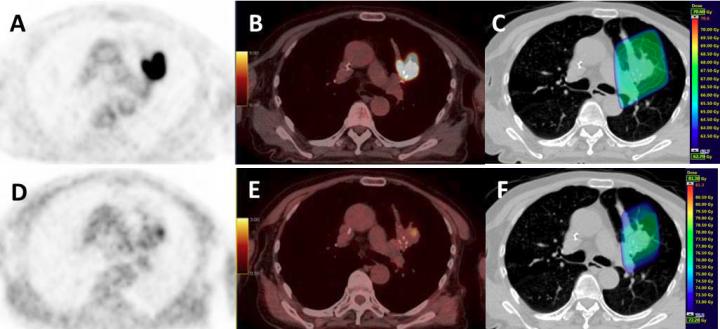
Credit: QuantIF – LITIS EA 4108 – FR CNRS 3638, Henri Becquerel Cancer Center, Rouen, France
RESTON, Va. – Fluorine-18 (18F)-fluoromisonidazole (FMISO) is a positron emission tomography (PET) radiotracer that is widely used to diagnose hypoxia (insufficient oxygen supply to tissue), and non-small cell lung cancer (NSCLC) patients with FMISO uptake are known to face a poor prognosis. A multicenter French Phase II study featured in the July issue of The Journal of Nuclear Medicine (JNM) investigated whether a selective radiotherapy (RT) dose increase to tumor areas with significant FMISO uptake in NSCLC patients could improve outcomes.
The study, conducted by 15 academic PET facilities across France, evaluated 54 patients with localized, advanced non-small cell cancers, who were undergoing chemoradiotherapy. For each patient, two FDG-PET/CT and two FMISO-PET/CT scans were performed using the same machine and under the identical operational conditions. Quality control was centrally supervised to secure homogeneity in the image quality in all participating centers. In 24 of the patients, the radiotherapy dose could be increased up to 86 Gy on hypoxic areas identified on FMISO PET/CT. Unfortunately, this dose increase did not improve patient outcomes.
On the bright side, Pierre Vera, MD, PhD, of the Henri Becquerel Cancer Center and Rouen University Hospital in Rouen, France, notes, "We demonstrate that this approach of radiotherapy boost based on hypoxia PET is feasible in a multicenter setting. Regarding the clinical aspect, a recent randomized trial (Bradley Lancet Oncol 2015) failed to demonstrate the benefit of escalated radiotherapy dose in large target volumes. Our data show that smaller volumes, identified on their functional characteristics using hypoxia PET/CT, can be adequately targeted. In addition, no significant toxicity has been observed in patients receiving radiotherapy boost."
###
In an invited perspective, also published in the July JNM, Rodney J. Hicks, MD, FRACP, FAHMS, of the Peter MacCallum Cancer Centre and the University of Melbourne in Melbourne, Australia, points out that negative results are instructive. He states, "Clearly, hypoxia remains an evil foe in our battle to achieve better outcomes in non-small cell cancer. But by demonstrating its importance, Vera and colleagues pose us the challenge to design new combination therapies. …[For example,] there may be synergy between radiation and check-point immunotherapy."
The authors of "Phase II study of a radiotherapy total dose increase in hypoxic lesions identified by FMISO PET/CT in patients with non-small cell lung carcinoma [RTEP5 study]" include Pierre Vera, MD, PhD, Romain Modzelewski, PhD, Pierre Bohn, PharmD, PhD; Sébastien Thureau, MD, Bernard Dubray, MD, PhD, and Sébastien Hapdey, PhD, Henri Becquerel Cancer Center (and QuantIF) and Rouen University Hospital, Rouen, France; Philippe Chaumet?Riffaud, MD, PhD, University Paris Sud, Paris, France; Maximilien Vermandel, PhD, University of Lille, Lille, France; Amandine Pallardy, MD, Nantes University Hospital, Nantes, France; Marc?André Mahé, MD, PhD, and Marie Lacombe, MD, Institut de Cancérologie de l'Ouest, Nantes, France; Pierre Boisselier, MD, and Sophie Guillemard, MD, Institut Régional du Cancer Montpellier (ICM), Montpellier, France; Pierre Olivier, MD, PhD, Brabois University Hospital, Nancy; France; Veronique Beckendorf, MD, Institut de Cancérologie de Lorraine, Nancy, France; Naji Salem, MD, and Nathalie Charrier, MD, Institut Paoli Calmette; Marseille, France; Enrique Chajon, MD, and Anne Devillers,MD, Centre regional de lutte contre le cancer de Bretagne Eugène Marquis; Rennes, France; Nicolas Aide, MD, PhD, Caen University Hospital and the François Baclesse Cancer Center's Unité Inserm U1086 ANTICIPE, Caen, France; Serge Danhier, MD, François Baclesse Cancer Center, Caen, France; Fabrice Denis, MD, PhD, and Jean?Pierre Muratet, MD, Institut Inter?Régional de Cancérologie (ILC). Centre Jean Bernard/Clinique Victor Hugo, Le Mans, France; Etienne Martin, MD, and Alina Berriolo Riedinger, MD, Centre Georges?Francois Leclerc, Dijon, France; Helène Kolesnikov?Gauthier, MD, and Eric Dansin, MD, Oscar Lambret Center, Lille, France; Carole Massabeau, MD, Institut Universitaire du Cancer, Toulouse, France; Fredéric Courbon, MD, PhD, Institut Claudius Regaud, Toulouse, France; Marie?Pierre Farcy Jacquet, MD, and Pierre?Olivier Kotzki, MD, PhD, CHU de Nîmes, Institut de cancérologie du Gard, Nîmes, France; Claire Houzard, MD, and Francoise Mornex, MD, PhD, Hospices Civils de Lyon, Lyon, France; Laurent Vervueren, MD, CHU Angers, Angers, France; Amaury Paumier, MD, Institut de Cancérologie de l'Ouest, Centre Paul Papin, Angers France; Philippe Fernandez MD, PhD, Hôpital Pellegrin, CHU de Bordeaux, Bordeaux, France; and Mathieu Salaun, MD, PhD, Normandy University, UNIROUEN, QuantIF, and Rouen University Hospital, Rouen, France.
Please visit the SNMMI Media Center to view the PDF of the study, including images, and more information about molecular imaging and personalized medicine. To schedule an interview with the researchers, please contact Laurie Callahan at 703-652-6773 or [email protected]. Current and past issues of The Journal of Nuclear Medicine can be found online at http://jnm.snmjournals.org.
About the Society of Nuclear Medicine and Molecular Imaging
The Society of Nuclear Medicine and Molecular Imaging (SNMMI) is an international scientific and medical organization dedicated to raising public awareness about nuclear medicine and molecular imaging, a vital element of today's medical practice that adds an additional dimension to diagnosis, changing the way common and devastating diseases are understood and treated and helping provide patients with the best health care possible.
SNMMI's more than 17,000 members set the standard for molecular imaging and nuclear medicine practice by creating guidelines, sharing information through journals and meetings and leading advocacy on key issues that affect molecular imaging and therapy research and practice. For more information, visit http://www.snmmi.org.
Media Contact
Laurie Callahan
[email protected]
@SNM_MI
http://www.snm.org
Original Source
http://www.snmmi.org/NewsPublications/NewsDetail.aspx?ItemNumber=24566 http://dx.doi.org/10.2967/jnumed.116.188367





